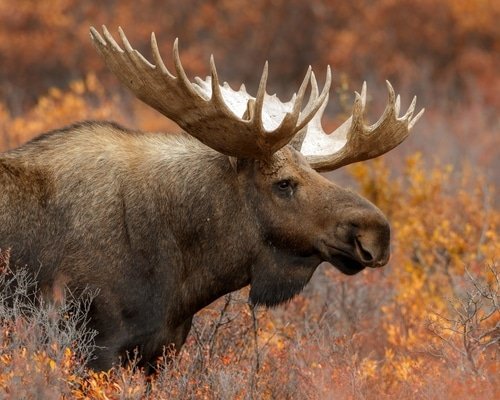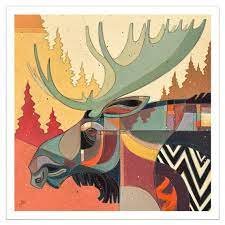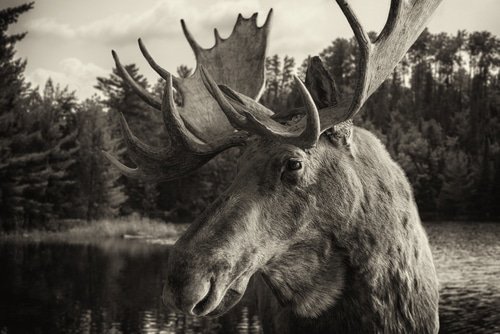Pursuing the magnificent moose requires determination, skill, and an intimate understanding of their behavior. From tracking bulls to perfecting your calling techniques, every aspect helps make your moose hunting season epic.

Moose species and their characteristics
Moose, scientifically known as Alces alces, are majestic creatures that belong to the deer family. These magnificent animals have several distinctive characteristics that make them fascinating to hunters and wildlife enthusiasts alike. The male moose, a bull, can reach towering heights of up to six feet on the shoulder and weigh up to 1,500 pounds.
Their iconic antlers stretching several feet from tip to tip symbolize strength and dominance during the mating season. Moose are also known for their long legs, allowing them to wade gracefully through various terrains such as marshes or deep snow.
Moose habitats, including forests, wetlands, and mountains
To embark on a successful moose hunting expedition, one must familiarize oneself with one’s preferred habitats. Moose have a remarkable ability to adapt and can be found in diverse environments across North America.
They favor dense forests with abundant vegetation, providing ample food sources like leaves, twigs, bark, aquatic plants, and shrubs. Moose particularly favor wetlands such as marshes or swamps due to their abundance of water plants.
Additionally, mountainous regions with ample foliage coverage provide ideal hiding spots for these elusive creatures. During your planning phase for the hunting season, tips suggest focusing on prime locations where moose sightings have been reported in these habitats.
Understanding their behavior patterns is crucial since different seasons may influence their movements—such as migration for food or mating purposes. You significantly increase your chances of a successful hunt by immersing yourself in their world and recognizing the best time to hunt moose based on habitat preferences and behavior patterns specific to your chosen hunting area.
Preparing for Moose Hunting Season
Obtaining Necessary Licenses and Permits: Hunting Legally
Embarking on a moose-hunting adventure requires more than just enthusiasm and a sharp aim. Before you can don your hunting gear and head out into the wilderness, obtaining the appropriate licenses and permits is imperative.
These regulations ensure your participation within the bounds of the law and contribute to the overall management and conservation of wildlife populations. The specific requirements may vary depending on your location, so checking with the local wildlife department or game warden for accurate information is essential.
They will guide you through the process, enlightening you on any prerequisites, fees, or restrictions that might apply. Remember, adhering to these regulations demonstrates responsible hunting practices while preserving the delicate ecological balance.
Firearms or Archery Equipment: Equipping Yourself Wisely
Precision and power are paramount When choosing firearms or archery equipment for moose hunting season. Larger calibers such as .30-06 Springfield or .300 Winchester Magnum are commonly preferred because they deliver sufficient stopping power required for taking down these majestic creatures effectively. However, it is essential to consider factors like personal comfort and familiarity with different firearm types before making a final decision.
If archery holds a special place in your heart, opt for bows with high draw weights that can penetrate moose hide effortlessly. Practice extensively with your chosen weapon beforehand; accuracy is key in ensuring an ethical hunt.
Essential Gear: Camouflage Clothing, Boots, Calls, and Scents
As you venture into the wilderness during moose hunting season, equipping yourself with appropriate gear becomes crucial for increasing your chances of success in spotting these elusive giants. Camouflage clothing will help you blend seamlessly with nature, providing a tactical advantage by breaking up your silhouette. Opt for patterns that mimic the forest’s natural colors and textures, ensuring you remain inconspicuous amidst the foliage.
Sturdy boots are essential for navigating rough terrains and keeping your feet comfortable during long outdoor hours. Investing in quality moose calls and scents can significantly enhance your hunting experience by attracting curious moose to your location.
Mimicking the vocalizations of a cow or imitating dominant bull grunts can lure these majestic creatures closer, allowing you to make that perfect shot. Remember, planning your hunt meticulously by obtaining necessary licenses and permits, selecting suitable firearms or archery equipment, and gathering essential gear will pave the way for a memorable and successful moose hunting season.
Scouting for Moose
Researching prime hunting areas
When preparing for moose hunting season, one of the key aspects is identifying the best hunting areas. To do this, conducting thorough research is crucial to gathering information from various sources. Talking to local hunters with experience in the area can be immensely helpful as they possess invaluable knowledge about moose behavior and migration patterns.
Additionally, consulting with wildlife management agencies or checking online forums dedicated to hunting can provide insightful tips and recommendations on prime moose locations. Understanding where moose have been sighted in the past and having access to local knowledge can significantly increase your chances of a successful hunt.
Identifying moose signs like tracks, rubs, scrapes, and droppings
Once you have narrowed down potential hunting areas based on research, it’s time to hit the ground and look for signs of moose presence. Moose leave behind distinct signs that indicate their recent activities. Tracks are an obvious clue; keep an eye out for large hoof prints in muddy or soft soil near feeding areas or water sources.
Another sign to look for is rubs, where male moose scrape their antlers against trees to mark territory or attract mates. These rubs often leave behind broken branches or stripped bark at shoulder height.
Scrapes are another indication – patches cleared by a male’s front hooves during mating season when they urinate in them to market their presence to females. Don’t overlook fresh droppings, as they provide evidence of recent moose activity.
Utilizing trail cameras to monitor moose movement patterns
In today’s era of advanced technology, trail cameras have become an indispensable tool for hunters aiming to gain insights into wildlife movement patterns without physically disturbing the environment. You can capture valuable images or videos of these majestic creatures by strategically placing trail cameras in areas with abundant moose signs. Trail cameras help identify the best time to hunt moose and reveal behavioral patterns such as the timing of their visits to feeding grounds, preferred trails, and potential bedding areas.
This information can be instrumental in planning your hunt effectively. However, it’s important to remember that trail cameras should be set up discreetly and checked regularly to avoid excessive disturbance and ensure optimal functioning.
Scouting for moose involves extensive research on prime hunting areas, identifying moose signs like tracks, rubs, scrapes, and droppings, and utilizing trail cameras to monitor their movement patterns. By combining these methods and techniques with local knowledge, hunters can significantly increase their chances of a successful hunt during the moose hunting season.
Patience and perseverance are essential when observing wildlife and adapting your strategy accordingly. Good luck with your moose-hunting adventure!
Techniques for Calling Moose
Different types of calls: cow calls, bull grunts, rattling antlers
To increase your chances of attracting moose, it’s crucial to master the art of calling. Various types of calls can be used during moose hunting season. Cow calls mimic the sounds made by female moose and can lure curious bulls closer.
These calls often include low, melodic tones indicating a cow searching for a mate. On the other hand, bull grunts imitate the deep, resonant vocalizations made by dominant males during the rutting season.
It’s important to practice these grunts with various intensities and rhythms to sound authentic. Additionally, rattling antlers create the illusion of two bulls clashing their antlers together, which can pique the interest of nearby moose.
Mastering the art of mimicking moose vocalizations to attract them closer
Mimicking moose vocalizations is essential for any serious hunter during moose hunting season. By accurately recreating the sounds made by these majestic creatures, you can create a sense of familiarity and draw them closer to your location.
To achieve this level of mastery, it’s beneficial to listen to recordings or watch videos of actual moose vocalizations to understand their unique cadence and tonal variations. Practice different pitches and durations until you feel confident in imitating these sounds effectively.
Tracking and Stalking Moose
Understanding wind direction to avoid detection
Tracking and stalking require patience, skill, and knowledge about moose behavior. One crucial element is understanding wind direction, as moose have an acute sense of smell.
Ensure that you position yourself upwind from your target so that your scent does not give away your presence. This will increase your chances of getting closer without being detected.
Effective tracking methods using blood trails or hoof prints
Tracking a wounded moose can be challenging, but you can follow their path by carefully analyzing blood trails and hoof prints. Look for large blood splatters or distinct tracks that suggest an injured animal.
Follow the trail methodically, noting any changes in direction or behavior. It’s important to exercise caution and be patient during this process, as injured moose may travel for some distance before bedding down.
Stealthy stalking techniques to get within shooting range
Stalking requires skill and finesse to get within shooting range without alerting the moose. Move slowly and deliberately, paying attention to every footstep to minimize noise.
Utilize natural cover such as trees, rocks, or vegetation to conceal your approach. Taking advantage of the terrain and utilizing crawling techniques when necessary can also aid in reducing visibility to increase your chances of a successful shot.
Field Dressing and Processing a Harvested Moose
Proper field dressing techniques to preserve meat quality
After harvesting a moose, it’s crucial to field dress it promptly to preserve the meat’s quality. Begin by making an incision from the sternum down towards the anus while being cautious not to puncture any organs.
Carefully remove internal organs like the heart, lungs, liver, and intestines. Keep the carcass clean and cool while elevating it off the ground if possible.
Transporting the carcass safely out of the hunting area
Transporting a harvested moose carcass out of the hunting area can be physically demanding but essential for preserving its meat quality. If possible, utilize game carts or sleds to ease the burden.
Alternatively, another option is quartering the carcass and packing it out in manageable loads. Remember to consider your physical limitations and seek assistance if needed.
Tips on processing meat into various cuts for consumption
Processing a moose into various cuts for consumption can be an enjoyable part of the hunting experience. Consider investing in a quality meat grinder, sharp knives, and a suitable workspace.
Begin by separating primal cuts such as loins, shoulders, and hindquarters. Depending on personal preference, these large sections can be further divided into steaks, roasts, ground meat, or even jerky.
Safety Considerations during Moose Hunting Season
Importance of firearm safety rules while hunting
Safety should always be paramount during moose hunting season. Familiarize yourself with proper firearm safety rules, such as always treating every firearm as if it is loaded and keeping your finger off the trigger until ready to shoot. Additionally, wear appropriate protective gear such as ear protection and safety glasses while handling firearms. Conclusion:
Moose hunting season offers a thrilling opportunity for outdoor enthusiasts to immerse themselves in nature while enjoying an adrenaline-filled pursuit. By mastering techniques for calling moose, honing tracking skills, and employing stealthy stalking methods, hunters can increase their chances of a successful harvest.
Proper field dressing techniques, safe transportation of the carcass out of the hunting area, and skillful processing ensure the hard-earned bounty is preserved for delectable meals shared with loved ones. Remember to always prioritize safety by adhering to firearm safety rules and regulations.






